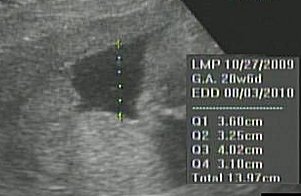

A normal single deepest pocket is 2 cm to 8 cm (less than 2 cm is oligohydramnios, greater than 8 cm is polyhydramnios). The entire uterus should be examined, and the single deepest vertical pocket of fluid should be identified and measured. The technique used to measure a single deepest pocket (also referred to as a maximum vertical pocket) is identical to the measurement of amniotic fluid amounts in the four quadrants used to determine an amniotic fluid index. In pregnancies less than 24 weeks, or with multiple gestations, a single deepest pocket is used.

The calipers may not cross over any segments of the umbilical cord or any fetal parts.Īlternative Measurements of Amniotic Fluid Volume Color Doppler is typically placed over the pocket of fluid to ensure that the pocket does not contain any segments of the umbilical cord, which are not always well seen in B-mode (standard 2D greyscale) imaging. The deepest vertical pocket of fluid in each quadrant should be identified and measured, and these four measurements should be added together to calculate the total amniotic fluid index. This ensures that each pocket of fluid is being measured in the same plane.

#Amniotic fluid index skin
The ultrasound transducer should be held perpendicular to the patient's spine, not perpendicular to the patient's skin as is performed in most other ultrasounds, and should be maintained in an axial plane (notch to the patient's right). Each quadrant should be examined systematically. The uterus should be divided into four quadrants to assess amniotic fluid index. Overdistension of the uterus is also a risk factor for postpartum hemorrhage after delivery. Polyhydramnios can lead to overdistension of the gravid uterus, especially in cases where the fetus is normal size or large for dates, which increases the patient's risk for preterm contractions and preterm delivery, as well as premature rupture of membranes, in which the patient's water breaks before the onset of labor. Polyhydramnios, or increased amniotic fluid volume, also has a number of potential causes, with two primary common mechanisms: decreased fetal swallowing of amniotic fluid, or increased fetal production of amniotic fluid. Since amniotic fluid is primarily made up of fetal urine, low amniotic fluid volume, or oligohydramnios, typically indicates either fetal urine output or leakage of amniotic fluid from the uterus, such as when the patient's water breaks. Many cases of polyhydramnios are idiopathic, meaning no definite cause is identified. In these cases, it may be associated with fetal macrosomia. Increased amniotic fluid production occurs as a result of fetal polyuria, such as in uncontrolled maternal diabetes with persistently elevated maternal blood sugars. This can occur due to gastrointestinal malformations, fetal neurologic problems such as anencephaly, or mechanical obstruction of the esophagus by other intrathoracic processes. If the fetus is unable to swallow the typical amounts of amniotic fluid, this can lead to polyhydramnios. The normal fetus is constantly swallowing amniotic fluid and urinating to create more fluid. Oligohydramnios can also occur because the patient's amniotic membrane has ruptured and amniotic fluid is leaking out of the uterus. Therefore, decreased amniotic fluid volume due to decreased urine production by the fetal kidney is a reflection of chronic hypoperfusion of the fetus. When the fetus receives inadequate nutrients and oxygen from the placenta, blood is shunted away from the fetal kidney, glomerular filtration rate decreases, and urinary output decreases. It is the same mechanism that causes oliguria in critically ill adults.

Decreased urine production by the fetal kidney typically reflects inadequate blood flow to the fetal kidney, caused by shunting of fetal blood flow away from the kidney to the heart and brain. Urinary tract obstruction can occur anywhere along the fetal urinary tract and can be catastrophic for the fetus. Etiology and Epidemiologyĭecreased fetal urine output can have a number of causes, which fall into two general categories: fetal urinary tract obstruction and decreased urine production by the fetal kidney. The amniotic fluid index is used in patients who are at least 24 weeks pregnant with a singleton gestation. The amniotic fluid index is a standardized way to assess the sufficiency of amniotic fluid quantity in pregnancy.


 0 kommentar(er)
0 kommentar(er)
